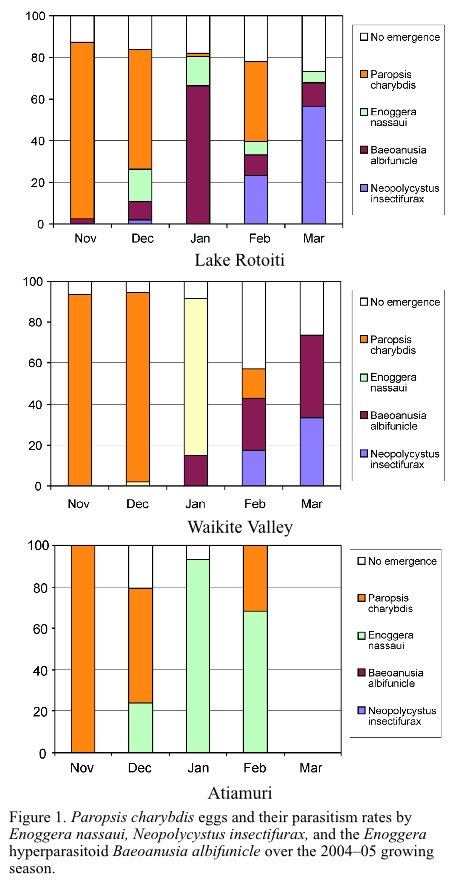PESTS AND DISEASES OF FORESTRY IN NEW ZEALAND
Current status of Paropsis charybdis in the Central North Island
Scion is the leading provider of forest-related knowledge in New Zealand
Formerly known as the Forest Research Institute, Scion has been a leader in research relating to forest health for over 50 years. The Rotorua-based Crown Research Institute continues to provide science that will protect all forests from damage caused by insect pests, pathogens and weeds. The information presented below arises from these research activities.
From Forest Health News 150, April 2005.
Enoggera nassaui is an egg parasitoid introduced into New Zealand in the late 1980s and again in 2000 for the biological control of the eucalyptus tortoise beetle Paropsis charybdis. In 2001 an obligate hyperparasitoid of E. nassaui , Baeoanusia albifunicle , was detected in New Zealand. That same year, another egg parasitoid of P. charybdis was recorded in New Zealand, thewasp Neopolycystus insectifurax . Attack rates of the two egg parasitoids and the hyperparasitoid have been monitored since the summer of 2001–02. Each summer P. charybdis egg batches have been collected from several Eucalyptus nitens plantations in the Bay of Plenty/Taupo region (see FH News 130:1 & 141:1).
For the 2004–05 summer, three plantations were monitored (Lake Rotoiti, Atiamuri, and Waikite Valley, Figure 1). Parasitism by E.nassaui increased from November to January then declined in February at all three sites. At Lake Rotoiti and Waikite Valley the hyperparasitoid followed a similar trend in abundance to E. nassaui but N. insectifurax was not collected until January, when it too began to increase in abundance. Neither B. albifunicle nor N.insectifurax have been recorded from Atiamuri. These trends are generally similar to those observed in previous summers, although B. albifunicle was recorded earlier in the summer at Lake Rotoiti than previously.

It appears E. nassaui will be effective in reducing P. charybdis populations in early summer and that N. insectifurax can provide some control of the second pest generation in late summer. In previous years E. nassaui attacked the second generation, but the hyperparasitoid now reduces the impact of E. nassaui on this second generation. Neopolycystus insectifurax (where it is present) appears able to compensate to some extent for the decline of E. nassaui populations.
Diane Jones, Toni Withers, and Sarah Mansfield, ForestResearch
This information is intended for general interest only. It is not intended to be a substitute for specific specialist advice on any matter and should not be relied on for that purpose. Scion will not be liable for any direct, indirect, incidental, special, consequential or exemplary damages, loss of profits, or any other intangible losses that result from using the information provided on this site.
(Scion is the trading name of the New Zealand Forest Research Institute Limited.)



